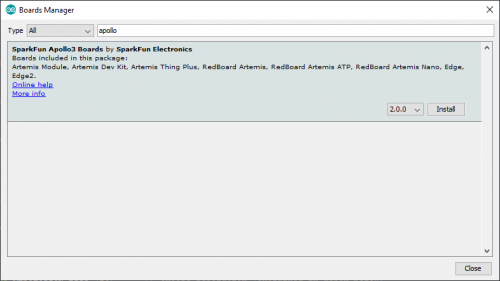Artemis Development with the Arduino IDE
Setting up the Arduino IDE
Installing the Arduino IDE
Most users will be familiar with the Arduino IDE and it's use. As a point of reference for professional developers who aren't aware, the Arduino IDE is an open-source development environment, written in Java, that makes it easy to write code and upload it to a supported board. For more details, feel free to check out the Arduino website.
To get started with the Arduino IDE, check out the following tutorials:
Installing an Arduino Library
What is an Arduino?
Installing Arduino IDE
Installing Board Definitions in the Arduino IDE
Installing the Apollo3 Board Definitions
Users will need to install the SparkFun Apollo3 Boards board definitions in the Arduino IDE for our development boards with an Artemis module. Please use the guide below, to get started with installing the SparkFun Apollo3 core for the Artemis modules:
Installing Board Definitions in the Arduino IDE
Otherwise, users can check out this tutorial on Installing Additional Cores provided by Arduino. Users will also need the .json file for the SparkFun Apollo3 Arduino Core:
Once, the .json file has been added to the Additional Boards Manager URLs, search for Apollo3 in the Boards Manager.
To complete the installation process, selected the SparkFun Apollo3 Boards core and click on the INSTALL button that appears in the lower, right-hand corner. The board definition along with the associated libraries and example sketches will be installed automatically. (*Make sure that the Apollo3 Arduino core is at least version 2.0.0.)
SparkFun's Apollo3 boards and examples listed in the Arduino IDE. (Click to enlarge)
Installing the BLE Library
For users interested in the BLE functionality of the Apollo3 and Artemis boards, we have provided full support to the Arduino BLE library. Additional details about the library can be referenced from the documentation provided by Arduino.
Users will need to install the Arduino BLE library to take advantage of that functionality; please use the guide below, to get started with installing the Arduino BLE library:


